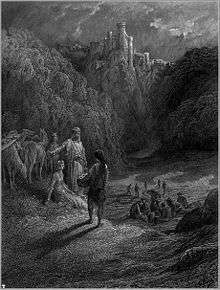Geraint

Geraint /ˈɡɛraɪnt/ is a character from Welsh folklore and Arthurian legend, a king of Dumnonia and a valiant warrior. He may have lived during or shortly prior to the reign of the historical Arthur, but some scholars doubt he ever existed. The name is a Welsh form of the Latin Gerontius meaning old man.
Historical figure
Geraint's father was said to be Erbin, a herder of sheep, and according to Culhwch and Olwen, he had brothers named Ermind and Dywel. A "Geraint of the South" appears at the Battle of Catraeth (circa 600) in the 14th-century poem Y Gododdin, attributed to Aneirin. Geraint was one of the "Three Seafarers of the Isle of Britain" according to the Welsh Triads. His deeds at the Battle of Llongborth are celebrated in the poem "Geraint son of Erbin", written probably in the 10th or 11th century,[1] and traditionally attributed to Llywarch Hen. However, Derek Bryce, following other scholars, suggests that the later, historical Geraint of Dumnonia (d. 710) may be identified as the real warrior eulogized in connection with the Battle of Llongborth in the poem, despite its title. Bryce identifies Llongborth with the 710 battle between that Geraint and Saxon leader Ine of Wessex.[2] Hypotheses about the location of the battle range from Somerset, bordering Dumnonia, to as far north as Kingdom of Strathclyde, if the Battle of Llongborth is simply another spelling for the 710 Battle of Longecoleth[2] (see P-Celtic) for p/b and c/g correspondences in Celtic languages). Strathclyde had rulers named Geraint and Erbin/Elfin in the same era, and was also known as Damnonia, after the Dumnonii tribe of the area in Romano-British times, and thus easily confused with Dumnonia/Devon.[2]
A King Geraint also appears in the "Life of Saint Teilo", a 6th-century monk. There are local legends of the folk saint King Geraint, patron saint of Gerrans, near Falmouth, being buried on Carne Beacon near Veryan. His feast day is 10 August.
Arthurian legend
He is probably most famous as the protagonist in the Welsh tale Geraint and Enid, where he becomes the lover of Enid. Geraint and Enid is one of the three Welsh Romances associated with the Mabinogion. Its story closely parallels the French writer Chrétien de Troyes's Erec and Enide. Some scholars feel both works derived from a common lost source, but most believe the Welsh version derives directly or indirectly from Chrétien. In this case, the renowned figure of Geraint would have been added to the story to suit Welsh audiences unfamiliar with Chrétien's protagonist. Geraint and Enid was reworked by Alfred, Lord Tennyson into the poems The Marriage of Geraint and Geraint and Enid, part of his Idylls of the King. The Arthurian character in later works is often referred to as Sir Geraint.
References
- ↑ Bollard, John K. (1994). "Arthur in the Early Welsh Tradition". The Romance of Arthur: An Anthology of Medieval Texts in Translation. Routledge. pp. 14–15.
- 1 2 3 Mackay, Ian (1999–2006). "Geraint, Son of Erbin". History of Drumchapel.